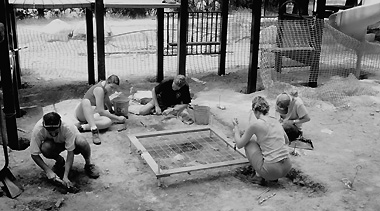![]()
Departments
![]()

|
Week of 8 October 1999 |
Vol. III, No. 9 |
Feature
Article
Ritual or victual?
Discovery of prehistoric tools in Quincy sets off archaeological shock waves
By Brian Fitzgerald
BU Archaeology Associate Professor Ricardo Elia (GRS'93) has participated in important field excavations around the world. But this summer it was a site 10 miles from campus that left him exhilarated: a cache of stone tools in Quincy that was buried by Native Americans 1,200 to 6,000 years ago.
|
|
|
Archaeology student Margo Muhl
Davis (GRS'02) measures part of a Native American
spear-throwing device. Its whale's tail shape
suggests a maritime function. Photo by Kalman Zabarsky
|
Sure enough, the find "is unprecedented in the area," says Elia. Archaeology students from BU and UMass-Boston dug a hole seven feet long and three and a half feet wide and found numerous stone hand axes, arrowheads, stone net sinkers, a whale-shaped woodworking tool, and an ornament and a stone weight -- both in the shape of a whale's tail. "The artifacts are mostly intact and undisturbed," he says. "And the appearance of red ochre suggests that they might have been a ritual offering." Red ochre, a common mineral oxide, is used in burials by many ancient cultures to symbolize blood.
Indeed, for her doctoral dissertation, archaeology student Margo Muhl Davis (GRS'02) will test some of the artifacts in a BU lab to determine if they were used for a ceremonial purpose, and if possible, how old they are. "The find is unbelievable," she says. "And the artifacts were an inch below where the ground had been bulldozed -- we were extremely lucky that the site was discovered."
It was a lucky and unlikely discovery. Construction was well under way on an MDC "tot lot." It was the third playground to be built on the site in recent years, and there had been no known archaeological finds. "However, we knew that the location was extremely sensitive because a number of Native American artifacts had been found in the area in the 1950s and '60s," says Mahlstedt. "Although the ground in the Quincy Shore Drive area had also been disturbed a lot over the years, we couldn't write it off completely, so we told the contractors what to look for: stone chipping and red earth, which could be ochre." The man who made the discovery, a construction worker for Hingham-based R. D. Corporation, was preparing to build a platform for a slide, and hit the 13-inch knife blade with a small shovel. Red earth was also found, so the chief engineer called Mahlstedt.
|
|
|
At the archaeological site in a
Quincy playground are (left to right) MDC employee
Emilio Savorito, Jennifer Sennott (CAS'98, GRS'01),
MDC archaeologist Thomas Mahlstedt, Margo Muhl
Davis (GRS'02), and UMass-Boston student Lorie
Conway. Photo by Ricardo
Elia
|
Red ochre is sometimes found at Native American burial sites, but no bones or ash were found in the Quincy area. "It's Margo's job to make sense of this in a nonburial context," says Elia. "It could be a cenotaph, a bodyless burial, possibly for a person who was lost at sea. They might have been trying to put his spirit to rest."
There are other possible scenarios as well. "It could simply be a highly specialized tool kit with flensing blades to cut whale blubber," says Mahlstedt. "In the fall, the ancient peoples here tended to move inland. They might have been storing the tools for the season, and the red ochre offered some sort of supernatural protection." Another possibility is a "votive offering," he adds, "which was never meant to be retrieved. It might have been for a maritime spirit to affect a bountiful fishing season. They believed in the god Maushop, a giant who provided stranded whales to them for food."
"Margo will look for wear patterns on the tools' edges," says Elia. "If there aren't any, that means that they were never used, bolstering a ritual interpretation of the find." Mahlstedt adds that if pollen is found in the bulk samples, it would indicate that the burial took place in late spring or summer, when whales were numerous in local waters.
As for the age of the artifacts, Davis explains that no carbon was found on the site, making it difficult to pinpoint when they were carved and buried. "It's possible that dating could be done with tiny flecks of carbon that have been mixed with red ochre," she says. "We're just beginning an in-depth analysis."

